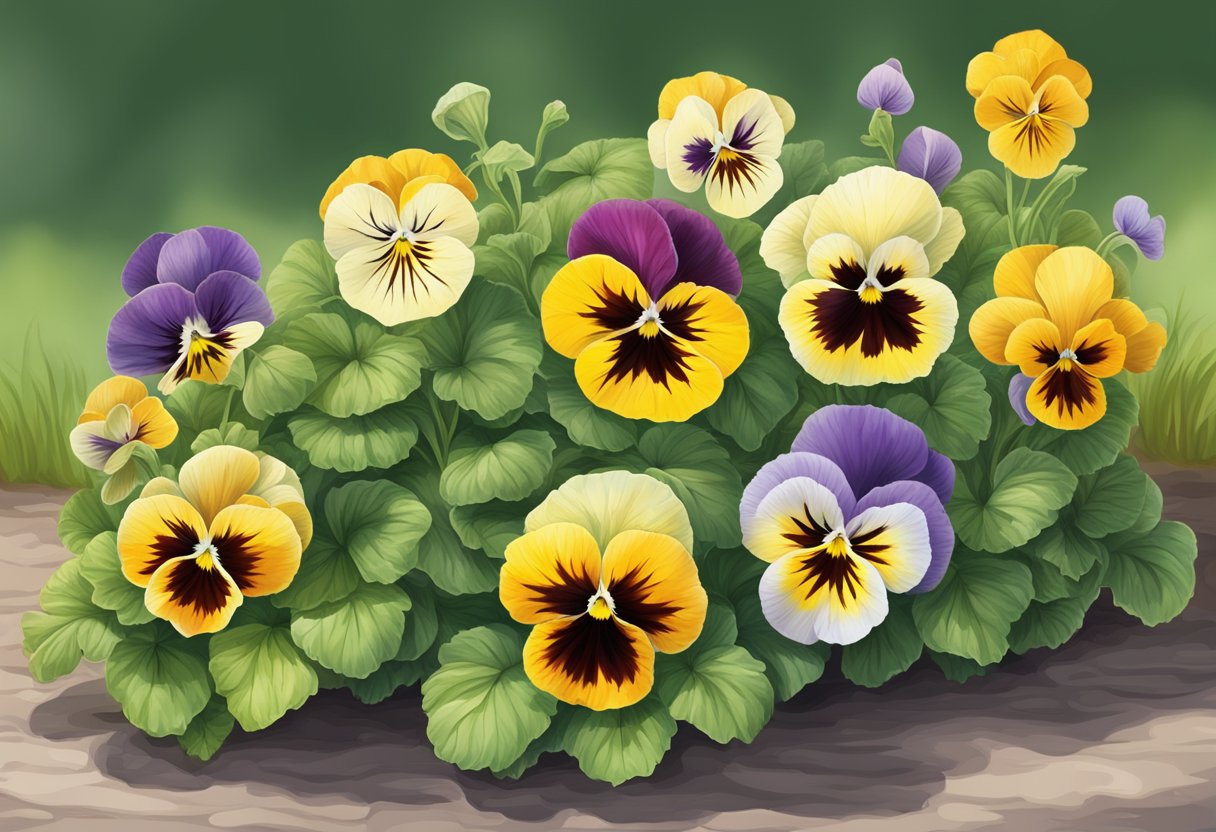Pansies are a popular choice for gardeners seeking color during the cooler months. Their vibrant hues and ability to withstand a chill make them an excellent choice for winter blooms. However, understanding the limits of their hardiness is crucial for their survival. While pansies flourish in cool weather, there’s a threshold temperature beyond which they may not survive.

In my gardening experience, I’ve found that pansies generally thrive best in temperatures ranging from 45°F to 65°F. This range is ideal for both growth and flowering. As the temperatures start to drop, pansies can withstand light frosts and even brief periods of colder weather, but prolonged exposure to extreme cold can be detrimental to their health.
When temperatures fall below 25°F, the flowers can wilt and the foliage may begin to die back. Severe cold, particularly below -10°F, often proves fatal to pansies.
Protecting pansies from severe winter conditions involves mulching and considering snow cover, which can act as an insulation against harsh temperatures. On the other hand, high temperatures can be just as threatening. Pansies exposed to temperatures above 80°F for extended periods may suffer, as they prefer cooler conditions to maintain their blooms. Therefore, it’s not only winter care we should focus on, but also ensuring pansies are not subjected to the intense heat of warmer seasons.
JUMP TO TOPIC
Optimal Conditions for Pansies
Creating a thriving environment for pansies means paying attention to several key factors, from temperature to soil management. Let’s explore how to cultivate these vibrant flowers effectively.
Temperature and Climate
Pansies prefer mild temperatures and generally thrive in the range of 40 to 60 degrees Fahrenheit (4 to 15 degrees Celsius). These flowers excel in cooler climates and can even withstand brief periods of frost. However, they struggle and may not survive in temperatures that drop below 25°F (-4°C) or rise above 70°F (21°C).
For optimal growth, keep pansies in cooler temperatures, specifically between 40°F and 60°F.
Soil and Watering Practices
Pansies fare best in rich, well-draining soil that retains moisture without becoming waterlogged. I recommend using soil with organic material like compost to provide nutrients. When watering pansies, the goal is to maintain moist but not soggy soil. Ensure consistent moisture, especially during dry spells, without overwatering, which can lead to root rot.
Sunlight and Fertilizer Needs
Pansies need direct sunlight to partial shade to flourish; aim for about 4 to 6 hours of sunlight daily. As for nutritional requirements, applying a liquid fertilizer every few weeks during the growing season ensures they receive essential nutrients. Alternatively, mix a slow-release fertilizer into the soil at planting for sustained feeding. Remember that pansies do not require excessive feeding, so it’s crucial to follow the dosages recommended on the product label.
Protecting Pansies in Winter
Winter months can bring about extreme cold that poses a threat to pansy plants. Here, I will share techniques to prevent and repair frost damage and discuss the essentials of proper mulching and insulation.
Preventing and Repairing Damage
When winter approaches, pansies require special attention to prevent damage from frost and harsh temperatures. I ensure that my pansies are planted in soil that maintains a temperature range between 45-65°F. If an unexpected frost alert is issued, I use frost cloths to cover my pansies, providing an extra layer of protection that insulates them from severe cold snaps. Frost cloth is light enough to prevent crushing the plants but effective in retaining heat. I typically install these covers in the late afternoon to trap daytime warmth.
Upon the first signs of limp or discolored foliage that indicate frost damage, I carefully remove the affected parts to prevent further damage to the plant.
Mulching and Insulation
Mulching serves as an essential strategy for winter care of pansies. By applying a thick layer of mulch, such as pine straw or bark, I ensure that the roots receive insulation from sudden temperature drops. This layer acts as a barrier that maintains stable soil temperatures and protects the plant’s root system.
- Apply a 2-3 inch layer around the base of the pansy without touching the stems directly.
- Choose organic mulches that will contribute to soil fertility as they decompose.
Ensure to remove the mulch in the spring to allow new growth to emerge unhindered.
Maintaining Healthy Pansies
To maintain healthy pansies, precise watering, correct fertilizing, and vigilant pest and disease management are key.
Watering and Nutrient Management
Proper watering is critical for pansies; I make sure the soil is moist but not waterlogged to protect the roots. Over-watering can lead to root rot; therefore, I ensure good drainage. I water my pansies early in the morning to allow foliage to dry out during the day, thus reducing disease risk.
For nutrients, I use a balanced fertilizer to promote vibrant blooms and robust foliage. Fertilizing is most beneficial during the growing season—I apply it every 4-6 weeks.
Pest and Disease Control
Pansies can be susceptible to pests like aphids and slugs, as well as diseases such as powdery mildew and anthracnose. I monitor my pansies regularly for signs of infestation or infection. If I spot aphids, I use a strong water spray or insecticidal soap to remove them. To deter slugs, I strategically place barriers or use organic slug bait.
To prevent fungal diseases, I ensure good air circulation around the plants and avoid overhead watering, which can promote fungi growth. When I see signs of powdery mildew or anthracnose, I remove affected leaves and apply a suitable fungicide, adhering to safety instructions.












